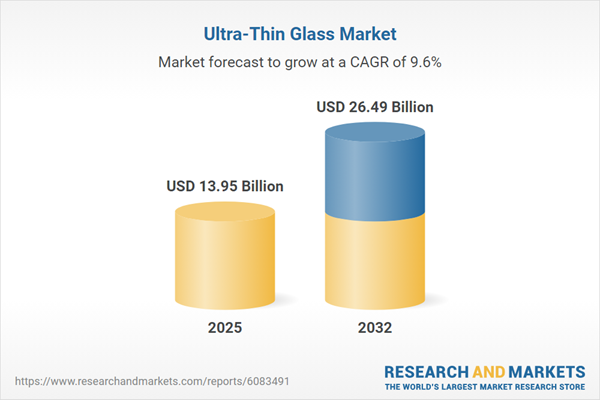Speak directly to the analyst to clarify any post sales queries you may have.
Ultra-thin glass is transforming product design and manufacturing strategy for senior leaders aiming to deliver lightweight, resilient, and adaptable solutions across diverse sectors. With advancing demands for sustainability, functional performance, and operational efficiency, ultra-thin glass presents actionable pathways to future-proof supply chains and strengthen competitive positioning.
Market Snapshot: Ultra-Thin Glass Market Growth and Trajectory
The ultra-thin glass market is projected to grow from USD 12.72 billion in 2024 to USD 13.95 billion in 2025, reaching USD 26.49 billion by 2032 at a robust CAGR of 9.60%. This expansion is driven by increased miniaturization within consumer electronics, evolving automotive design requirements, and the broader integration of advanced glass in solar applications. Industry stakeholders are prioritizing materials that offer versatility and high technical performance tailored to emerging device formats and renewable energy systems.
Scope & Segmentation
This report delivers detailed segmentation and practical insights to support strategic planning for ultra-thin glass market participants:
- Material Types: Aluminosilicate provides heightened durability for demanding settings; borosilicate ensures chemical and thermal stability; soda lime addresses price-sensitive requirements with stable properties.
- Thickness Ranges: Ultra-thin options under 0.5 mm fit flexible electronics and innovation-focused designs; 0.5 to 1.0 mm supports products where balanced strength is essential; greater than 1.0 mm suits load-bearing and structural needs.
- Processing Technologies: Chemical tempering strengthens surfaces for durability; float glass processing enables efficient, scalable production; ion exchange further boosts scratch and impact resistance for high-reliability use-cases.
- Applications: Automotive components leverage material adaptability; displays span mobile, tablet, and fixed screens; pharmaceutical packaging benefits from purity and strength; photovoltaic and building-integrated solar solutions rely on ultra-thin profiles.
- End Users: Sectors include consumer electronics manufacturers seeking next-generation device materials, energy organizations driving grid modernization, healthcare providers prioritizing safety, industrial OEMs optimizing manufacturing, and transportation companies upgrading fleets.
- Regions: Global coverage includes the Americas with a technology adoption focus, Europe emphasizing low-carbon integration, Middle East & Africa targeting infrastructure growth, and Asia-Pacific driving capacity scale and technological implementation.
- Key Companies: Examines major producers such as Corning Incorporated, AGC Inc., SCHOTT AG, Nippon Electric Glass Co., Ltd., Guardian Industries Corp., Nitto Denko Corporation, Hilgenberg GmbH, Samsung Electronics Co., Ltd., Hoya Candeo Optronics Corporation, and Blue Star Glass Co., Ltd.
Key Takeaways for Senior Decision-Makers
- Ultra-thin glass enables flexible, robust substrates, which are essential for advancing the next generation of electronics and innovative automotive interiors.
- Stronger collaboration between device manufacturers and suppliers accelerates development timelines and expands possible end-use scenarios.
- Environmental responsibility is reshaping production choices as closed-loop recycling and water-saving processes become industry norms.
- Material selection is increasingly specialized: aluminosilicate supports harsh environment use; soda lime offers economical choices for price-sensitive projects.
- Manufacturers are scaling production capacity and refining surface enhancement techniques to keep pace with demand in emerging solar and display segments.
- Regional strategies are distinct: North American firms leverage R&D synergies, European organizations emphasize sustainability, and Asia-Pacific drives process innovation and volume output.
Tariff Impact: Strategic Response Planning
Upcoming US tariff adjustments in 2025 are expected to alter cost structures across the ultra-thin glass supply network. Companies that maintain integrated operations or regional alliances will be better equipped to manage pricing volatility and preserve access to technically advanced substrates. Organizations focusing on resilient sourcing strategies, such as implementing nearshoring and dual-supplier systems, can mitigate supply chain disruptions and maintain a competitive edge amid evolving trade and procurement landscapes.
Methodology & Data Sources
This analysis draws from interviews with executives at leading manufacturers, insights from automotive, display, and energy sector experts, and data triangulated from technical journals, regulatory reports, and proprietary databases. Robust industry frameworks and validation protocols underpin all research findings presented here.
Why This Report Matters
- Enables senior stakeholders to identify high-growth ultra-thin glass opportunities and align investments with shifting market and technology trends.
- Supports agile risk management and informed planning through guidance on tariff impacts and best practices for resilient sourcing.
- Equips decision-makers with actionable intelligence spanning all key markets and application areas, accelerating effective go-to-market strategies and long-term sustainability planning.
Conclusion
This report provides industry leaders with a strategic platform for navigating material innovation and enhancing business resilience. Proactive adaptation and collaboration will anchor future growth within the ultra-thin glass landscape.
Table of Contents
3. Executive Summary
4. Market Overview
7. Cumulative Impact of Artificial Intelligence 2025
Companies Mentioned
The companies profiled in this Ultra-Thin Glass market report include:- Corning Incorporated
- AGC Inc.
- SCHOTT AG
- Nippon Electric Glass Co., Ltd.
- Guardian Industries Corp.
- Nitto Denko Corporation
- Hilgenberg GmbH
- Samsung Electronics Co., Ltd.
- Hoya Candeo Optronics Corporation
- Blue Star Glass Co.,Ltd.
Table Information
| Report Attribute | Details |
|---|---|
| No. of Pages | 194 |
| Published | November 2025 |
| Forecast Period | 2025 - 2032 |
| Estimated Market Value ( USD | $ 13.95 Billion |
| Forecasted Market Value ( USD | $ 26.49 Billion |
| Compound Annual Growth Rate | 9.6% |
| Regions Covered | Global |
| No. of Companies Mentioned | 11 |









